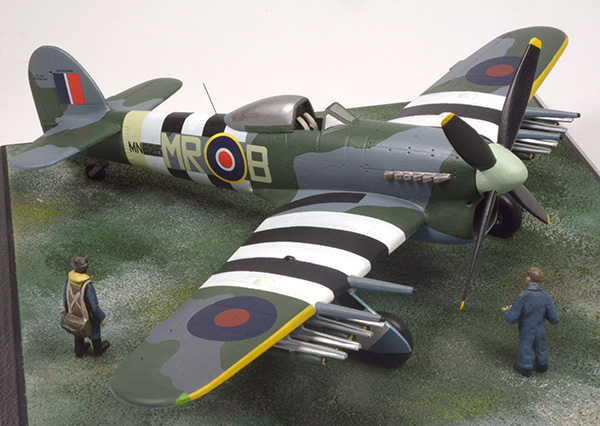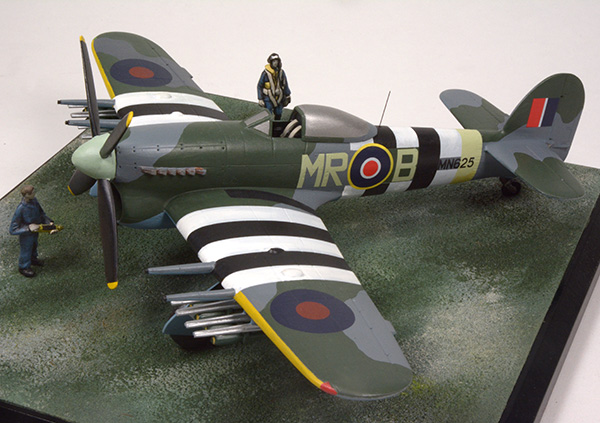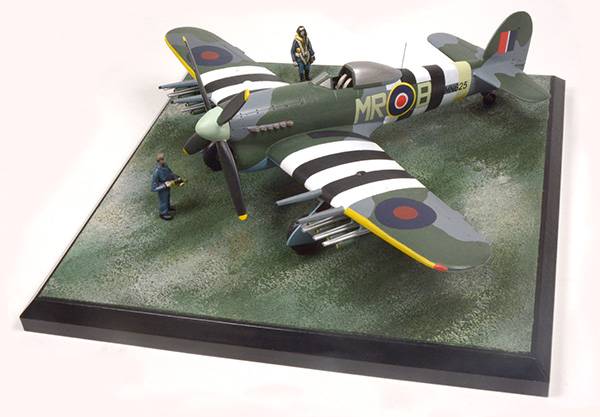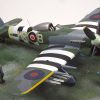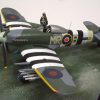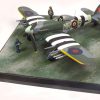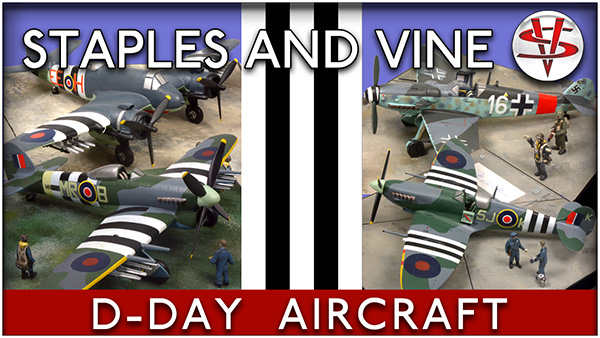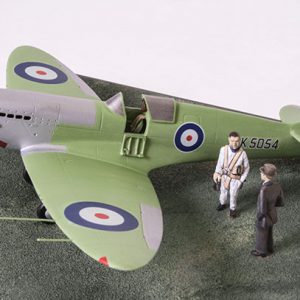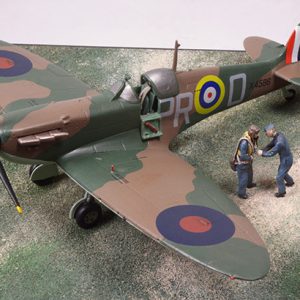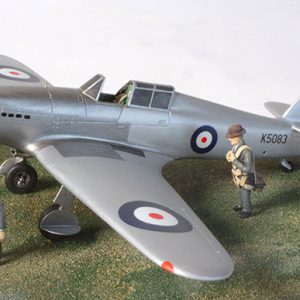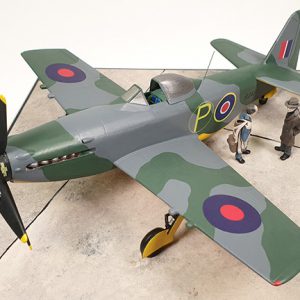Hawker Typhoon Mk IB MN625 MR-B 245 Squadron,
Fg.Off. W Smith, RAF Holmesley South, June 6th 1944 D-Day.
FIND OUT MORE ABOUT THE TYPHOON MK IB
ON MY YOUTUBE CHANNEL BELOW
In the last few days of 1937 Hawker Hurricanes, the first of the RAF’s monoplane fighters to enter front-line service, joined 111 Squadron at RAF Northolt, but already in the previous July Hawkers had submitted to the Air Ministry their ideas on a successor to be powered by one of a new generation of engines giving twice the power. By March 1938 this had been developed in to Specification F.18/37 for a fighter to replace the Hurricane and Spitfire; its issue to Hawkers resulted in the Tornado and Typhoon, with the same basic airframe but with different engines. Because of early difficulties with the Napier Sabre the Rolls-Royce Vulture-powered Tornado – which later also flew with the Bristol Centaurus – was the first to fly, in October 1939, with the Typhoon following in February 1940, but because of problems with the Vulture it was the Typhoon which was selected for development and service.
The intended armament for the Typhoon was four 20mm. cannon, but problems with their feed mechanism led to the first 110 production aircraft – built like all but a dozen production Typhoons by Gloster at Hucclecote – being fitted with twelve machine guns and designated Typhoon Ia. Ahead of its service entry trials revealed that although faster that the Spitfire the Typhoon was somewhat less nimble, and it was suggested that as an interceptor the aircraft would be better at lower levels. The first operational unit to receive the new fighter, 56 Squadron took delivery at Duxford in September 1941; the engine was still giving problems, and there was a series of airframe failures, particularly just in front of the tail unit, this eventually alleviated by local strengthening.
Preparations for the air forces’ part in the assault on Europe took considerable account of the part played in North Africa by the Desert Air Force, particularly in the need for mobility when pursuing the opposing armies. Exercise Spartan, held in East Anglia in March 1943, was the first major test of the proposed organization; Typhoons played only a limited part in this, the majority of single-seat fighters being Spitfires and Mustangs, the latter absorbed in to Fighter Command when the assets of Army Cooperation Command were transferred. Lessons from Spartan played their part in Exercise Starkey, in October 1943; squadrons, generally three at a time, were formed in to “Airfields” which, accompanied by their designated servicing echelons, would fight and move as an entity. By now it was evident that the best use for the Typhoon was as a ground attack aircraft, and by June 1944 twenty Typhoon squadrons in this role were part of the Second Tactical Air Force; 2nd TAF also had its own interceptor fighter units, formed in the same manner and equipped with Spitfires, while the remainder of Fighter Command had been designated Air Defence of Great Britain.
The Second Tactical Air Force came in to formal being on 15 November 1943, and as part of its structure 174, 175 and 245 squadrons at Westhampnett became 121 “Airfield”; with the term “Wing” becoming increasingly common the three squadrons stayed together until the end of hostilities, moving on 1 April 1944 to Holmesley South, one of the many airfields in the New Forest that were part of the springboard for the coming operation. By this time Typhoon squadrons were specialising in either bombing or rocket projectile operations, with the underwing fittings permanently installed; 245’s weapon of choice was the RP, which they carried until after the end of hostilities in Europe. As with all the Typhoon squadrons 245 were in action early on 6 June; half of these squadrons attacked nominated targets while the others waited in airborne readiness just offshore, to be called forward if a new target presented itself. By 0750 MN459 of 245 had been hit by flak near Talleville, but although wounded its pilot Flt.Lt. R A Gordon was able to re-cross the Channel, landing his damaged aircraft at Ford. With the black and white “Distinctive Markings” carefully applied – both individual letter and serial were left visible – MN625 joined the squadron as a replacement for MN377, an earlier “B” lost south of Caen on D+1; it was flown by Fg.Off. W Smith who, a few days later, was the first Allied pilot to land at one of the “temporary” airfields on the continent, in this case B5/Camilly which became the squadron’s operating base for the next two months before the Allied advance continued, although at the start the aircraft had returned to their UK bases overnight. On 20 March 121 Wing became the first Allied formation to operate from German soil, from B.100/ Goch, moving after the war to B.164 Schleswigland where it was disbanded in August.
More than 500 Typhoons were lost on post D-day operations, less than 50 in air-to-air combat, and they had themselves claimed fifty “kills”. There were enough left in service with a single squadron to represent the type in the big commemorative Battle of Britain flypast on 15 September 1945, but by the end of the year the Typhoon had left front-line duties, those of interception for which it had initially been intended now in the hands the Tempest. The Typhoon has acquired an immortality in the role for which it was adapted, and has now become symbolic of the army support task post D-Day, aided perhaps by its very pugnacious appearance and the tenacity of the way in which the black and white stripes seem to cling to its image, even though these were gone by the end of 1944.


